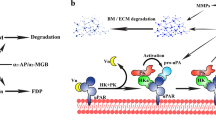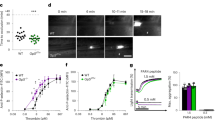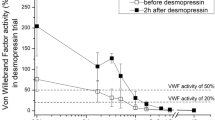Abstract
In the event of a myocardial infarction, current interventions aim to reopen the occluded vessel to reduce myocardial damage and injury. Although reperfusion is essential for tissue salvage, it can cause further damage and the onset of inflammation. We show a novel anti-inflammatory effect of a fibrin-derived peptide, Bβ15–42. This peptide competes with the fibrin fragment N-terminal disulfide knot-II (an analog of the fibrin E1 fragment) for binding to vascular endothelial (VE)-cadherin, thereby preventing transmigration of leukocytes across endothelial cell monolayers. In acute or chronic rat models of myocardial ischemia-reperfusion injury, Bβ15–42 substantially reduces leukocyte infiltration, infarct size and subsequent scar formation. The pathogenic role of fibrinogen products is further confirmed in fibrinogen knockout mice, in which infarct size was substantially smaller than in wild-type animals. Our findings conclude that the interplay of fibrin fragments, leukocytes and VE-cadherin contribute to the pathogenesis of myocardial damage and reperfusion injury. The naturally occurring peptide Bβ15–42 represents a potential candidate for reperfusion therapy in humans.
NOTE: In the HTML version of this paper originally published online, the name of an author was given incorrectly. The correct name for Peter Fried is Peter Friedl. Also, the first affiliation was given incorrectly. The correct affiliation is Department of General Dermatology, Medical University of Vienna, 18-20 Waehringer Guertel, Vienna, 1090, Austria. These errors have been corrected in the HTML version of the article.
This is a preview of subscription content, access via your institution
Access options
Subscribe to this journal
Receive 12 print issues and online access
$209.00 per year
only $17.42 per issue
Buy this article
- Purchase on Springer Link
- Instant access to full article PDF
Prices may be subject to local taxes which are calculated during checkout






Similar content being viewed by others
Change history
23 February 2005
The HTML version was updated with the correct spelling of Author's name and correct affiliation
References
Frangogiannis, N.G., Smith, C.W., & Entman, M.L. The inflammatory response in myocardial infarction. Cardiovasc. Res. 53, 31–47 (2002).
Kakkar, A.K. & Lefer, D.J. Leukocyte and endothelial adhesion molecule studies in knockout mice. Curr. Opin. Pharmacol. 4, 154–158 (2004).
Muller, W.A., Weigl, S.A., Deng, X., & Phillips, D.M. PECAM-1 is required for transendothelial migration of leukocytes. J. Exp. Med. 178, 449–460 (1993).
Schenkel, A.R., Mamdouh, Z., Chen, X., Liebman, R.M., & Muller, W.A. CD99 plays a major role in the migration of monocytes through endothelial junctions. Nat. Immunol. 3, 143–150 (2002).
Weber, C. Novel mechanistic concepts for the control of leukocyte transmigration: specialization of integrins, chemokines, and junctional molecules. J. Mol. Med. 81, 4–19 (2003).
Shaw, S.K., Bamba, P.S., Perkins, B.N., & Luscinskas, F.W. Real-time imaging of vascular endothelial-cadherin during leukocyte transmigration across endothelium. J. Immunol. 167, 2323–2330 (2001).
Bach, T.L., Barsigian, C., Yaen, C.H., & Martinez, J. Endothelial cell VE-cadherin functions as a receptor for the beta15-42 sequence of fibrin. J Biol. Chem. 273, 30719–30728 (1998).
Gorlatov, S. & Medved, L. Interaction of fibrin(ogen) with the endothelial cell receptor VE-cadherin: mapping of the receptor-binding site in the NH2-terminal portions of the fibrin beta chains. Biochemistry 41, 4107–4116 (2002).
Chalupowicz, D.G., Chowdhury, Z.A., Bach, T.L., Barsigian, C. & Martinez, J. Fibrin II induces endothelial cell capillary tube formation. J. Cell Biol. 130, 207–215 (1995).
Hamaguchi, M., Bunce, L.A., Sporn, L.A., & Francis, C.W. Spreading of platelets on fibrin is mediated by the amino terminus of the beta chain including peptide beta 15-42. Blood 81, 2348–2356 (1993).
Harley, S.L., Sturge, J. & Powell, J.T. Regulation by fibrinogen and its products of intercellular adhesion molecule-1 expression in human saphenous vein endothelial cells. Arterioscler. Thromb. Vasc. Biol. 20, 652–658 (2000).
Ribes, J.A., Ni, F., Wagner, D.D., & Francis, C.W. Mediation of fibrin-induced release of von Willebrand factor from cultured endothelial cells by the fibrin beta chain. J. Clin. Invest. 84, 435–442 (1989).
Altieri, D.C., Duperray, A., Plescia, J., Thornton, G.B., & Languino, L.R. Structural recognition of a novel fibrinogen gamma chain sequence (117-133) by intercellular adhesion molecule-1 mediates leukocyte-endothelium interaction. J. Biol. Chem. 270, 696–699 (1995).
Yokoyama, K., Zhang, X.P., Medved, L. & Takada, Y. Specific binding of integrin alpha v beta 3 to the fibrinogen gamma and alpha E chain C-terminal domains. Biochemistry 38, 5872–5877 (1999).
Altieri, D.C., Plescia, J. & Plow, E.F. The structural motif glycine 190-valine 202 of the fibrinogen gamma chain interacts with CD11b/CD18 integrin (alpha M beta 2, Mac-1) and promotes leukocyte adhesion. J. Biol. Chem. 268, 1847–1853 (1993).
Farrell, D.H., Thiagarajan, P., Chung, D.W., & Davie, E.W. Role of fibrinogen alpha and gamma chain sites in platelet aggregation. Proc. Natl. Acad. Sci. USA 89, 10729–10732 (1992).
Loike, J.D. et al. CD11c/CD18 on neutrophils recognizes a domain at the N terminus of the A alpha chain of fibrinogen. Proc. Natl. Acad. Sci. USA 88, 1044–1048 (1991).
Drew, A.F., Liu, H., Davidson, J.M., Daugherty, C.C. & Degen, J.L. Wound-healing defects in mice lacking fibrinogen. Blood 97, 3691–3698 (2001).
Drew, A.F. et al. Crescentic glomerulonephritis is diminished in fibrinogen-deficient mice. Am. J. Physiol. Renal. Physiol. 281, F1157–F1163 (2001).
Wilberding, J.A. et al. Development of pulmonary fibrosis in fibrinogen-deficient mice. Ann. NY Acad. Sci. 936, 542–548 (2001).
Palumbo, J.S. et al. Spontaneous hematogenous and lymphatic metastasis, but not primary tumor growth or angiogenesis, is diminished in fibrinogen-deficient mice. Cancer Res. 62, 6966–6972 (2002).
Olexa, S.A., Budzynski, A.Z., Doolittle, R.F., Cottrell, B.A. & Greene, T.C. Structure of fragment E species from human cross-linked fibrin. Biochemistry 20, 6139–6145 (1981).
Vali, Z. & Scheraga, H.A. Localization of the binding site on fibrin for the secondary binding site of thrombin. Biochemistry 27, 1956–1963 (1988).
Groger, M. et al. A standardized, a computer-assisted in vitro assay for the assessment of neutrophil transmigration across endothelial monolayers. J. Immunol. Methods 222, 101–109 (1999).
Halama, T. et al. PECAM-1 and VE-cadherin cooperatively regulate FGF-induced modulations of adherens junction functions. J. Invest. Dermatol. 116, 67 (2001).
Ferrans, V.J. Morphological methods for evaluation of myocardial protection. Ann. Thorac. Surg. 20, 11–20 (1975).
Koenig, W., Rothenbacher, D., Hoffmeister, A., Griesshammer, M. & Brenner, H. Plasma fibrin D-dimer levels and risk of stable coronary artery disease: results of a large case-control study. Arterioscler. Thromb. Vasc. Biol. 21, 1701–1705 (2001).
Schoots, I.G., Levi, M., Roossink, E.H., Bijlsma, P.B., & van Gulik, T.M. Local intravascular coagulation and fibrin deposition on intestinal ischemia-reperfusion in rats. Surgery 133, 411–419 (2003).
Erlich, J.H. et al. Inhibition of the tissue factor-thrombin pathway limits infarct size after myocardial ischemia-reperfusion injury by reducing inflammation. Am. J. Pathol. 157, 1849–1862 (2000).
Coughlin, S.R. Thrombin signalling and protease-activated receptors. Nature 407, 258–264 (2000).
Sherman, D.G. et al. Intravenous ancrod for treatment of acute ischemic stroke: the STAT study: a randomized controlled trial. Stroke Treatment with Ancrod Trial. JAMA 283, 2395–2403 (2000).
Simpson, P.J., Schelm, J.A. & Smith, G.F. Therapeutic defibrination with ancrod does not protect canine myocardium from reperfusion injury. J. Pharmacol. Exp. Ther. 256, 780–786 (1991).
Dempfle, C.E. et al. Analysis of fibrin formation and proteolysis during intravenous administration of ancrod. Blood 96, 2793–2802 (2000).
Kudryk, B. et al. Measurement in human blood of fibrinogen/fibrin fragments containing the B beta 15-42 sequence. Thromb. Res. 25, 277–291 (1982).
Harenberg, J., Stehle, G. & Waibel, S. Biodistribution of human fibrinogen derived peptides in rabbits. in Fibrinogen—structure variants and interactions. 271–278 (Walter de Gruyter & Co. Berlin, New York, 1985).
Everse, S.J., Spraggon, G., Veerapandian, L., Riley, M. & Doolittle, R.F. Crystal structure of fragment double-D from human fibrin with two different bound ligands. Biochemistry 37, 8637–8642 (1998).
Kostelansky, M.S., Betts, L., Gorkun, O.V. & Lord, S.T. 2.8 A crystal structures of recombinant fibrinogen fragment D with and without two peptide ligands: GHRP binding to the “b” site disrupts its nearby calcium-binding site. Biochemistry 41, 12124–12132 (2002).
Lounes, K.C., Ping, L., Gorkun, O.V., & Lord, S.T. Analysis of engineered fibrinogen variants suggests that an additional site mediates platelet aggregation and that “B-b” interactions have a role in protofibril formation. Biochemistry 41, 5291–5299 (2002).
Weisel, J.W., Veklich, Y. & Gorkun, O. The sequence of cleavage of fibrinopetides from fibrinogen is important for protofibril formation and enhancement of lateral aggregation in fibrin clots. J. Mol. Biol. 232, 285–297 (1993).
Hsieh, K. Thrombin interaction with fibrin polymerization sites. Thromb. Res. 86, 301–316 (1997).
Hsieh, K. Localization of an effective fibrin beta-chain polymerization site: implications for the polymerization mechanism. Biochemistry 36, 9381–9387 (1997).
Furlan, M., Rupp, C., Beck, E.A., & Svendsen, L. Effect of calcium and synthetic peptides on fibrin polymerization. Thromb. Haemost. 47, 118–121 (1982).
Qi, J., Goralnick, S., & Kreutzer, D.L. Fibrin regulation of interleukin-8 gene expression in human vascular endothelial cells. Blood 90, 3595–3602 (1997).
Lalla, R.V., Tanzer, M.L., & Kreutzer, D.L. Identification of a region of the fibrin molecule involved in upregulation of interleukin-8 expression from human oral squamous cell carcinoma cells. Arch. Oral Biol. 48, 263–271 (2003).
Unger, R.E., Krump-Konvalinkova, V., Peters, K. & Kirkpatrick, C.J. In vitro expression of the endothelial phenotype: comparative study of primary isolated cells and cell lines, including the novel cell line HPMEC-ST1.6R. Microvasc. Res. 64, 384–397 (2002).
Petzelbauer, P., Watson, C.A., Pfau, S.E., & Pober, J.S. IL-8 and angiogenesis: evidence that human endothelial cells lack receptors and do not respond to IL-8 in vitro. Cytokine 7, 267–272 (1995).
Gröger, M. et al. A standardized, a computer-assisted in vitro assay for the assessment of neutrophil transmigration across endothelial monolayers. J. Immunol. Methods 222, 101–109 (1999).
Zacharowski, K. et al. Selective activation of the prostanoid EP(3) receptor reduces myocardial infarct size in rodents. Arterioscler. Thromb. Vasc. Biol. 19, 2141–2147 (1999).
Ploplis, V.A. et al. A total fibrinogen deficiency is compatible with the development of pulmonary fibrosis in mice. Am. J. Pathol. 157, 703–708 (2000).
Acknowledgements
This work was supported by research grants from the Austrian Science Foundation (P15099 to P.P.), the Stavros Niarchos foundation (to K.W.) and the Deutsche Forschungsgemeinschaft (Za243/8-1 to K.Z.). We wish to thank the following persons: B. Binder of the Institute of Vascular Biology and Thrombosis Research, School of Medicine, University of Vienna, for providing NDSK; U.M. Losert and the staff of the Biomedical Sciences Center, School of Medicine, University of Vienna. Also A. Treiber, M. Sager and the staff of the Biological Sciences Unit, University Hospital of Dusseldorf.
Author information
Authors and Affiliations
Corresponding author
Ethics declarations
Competing interests
Peter Petzelbauer is a founder of a pharmaceutical company (Fibrex Medical R&D), which owns the rights to commercialize peptide Bβ15-42 for therapeutic use. Parts of the surgical equipment have been provided by Fibrex Medical R&D.
Supplementary information
Supplementary Fig. 1
AR of isolated rat hearts subjected to myocardial ischemia/reperfusion. (PDF 43 kb)
Supplementary Fig. 2
AR of rat hearts subjected to acute myocardial ischemia/reperfusion. (PDF 32 kb)
Supplementary Fig. 3
AR of rat hearts subjected to chronic myocardial ischemia/reperfusion. (PDF 81 kb)
Supplementary Fig. 4
AR of mice hearts subjected to acute myocardial ischemia/reperfusion. (PDF 37 kb)
Supplementary Table 1
Effects of Bβ15-42 on clotting parameters in the rat (n = 3/group). (PDF 40 kb)
Rights and permissions
About this article
Cite this article
Petzelbauer, P., Zacharowski, P., Miyazaki, Y. et al. The fibrin-derived peptide Bβ15–42 protects the myocardium against ischemia-reperfusion injury. Nat Med 11, 298–304 (2005). https://doi.org/10.1038/nm1198
Received:
Accepted:
Published:
Issue Date:
DOI: https://doi.org/10.1038/nm1198
This article is cited by
-
FX06 to rescue SARS-CoV-2-induced acute respiratory distress syndrome: a randomized clinical trial
Critical Care (2023)
-
The Role of P53 in Myocardial Ischemia-Reperfusion Injury
Cardiovascular Drugs and Therapy (2023)
-
The role and mechanisms of microvascular damage in the ischemic myocardium
Cellular and Molecular Life Sciences (2023)
-
Potential of FX06 to prevent disease progression in hospitalized non-intubated COVID-19 patients — the randomized, EU-wide, placebo-controlled, phase II study design of IXION
Trials (2022)
-
Exercise-induced peptide TAG-23 protects cardiomyocytes from reperfusion injury through regulating PKG–cCbl interaction
Basic Research in Cardiology (2021)



